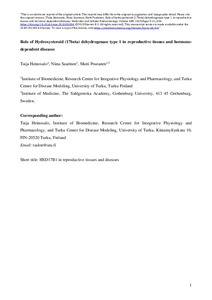Role of hydroxysteroid (17beta) dehydrogenase type 1 in reproductive tissues and hormone-dependent diseases
Heinosalo T.; Saarinen N.; Poutanen M.
https://urn.fi/URN:NBN:fi-fe2021042719729
Tiivistelmä
Abnormal synthesis and metabolism of sex steroids is involved in the pathogenesis of various human diseases, such as endometriosis and cancers arising from the breast and uterus. Steroid biosynthesis is a multistep enzymatic process proceeding from cholesterol to highly active sex steroids via different intermediates. Human Hydroxysteroid (17beta) dehydrogenase 1 (HSD17B1) enzyme shows a high capacity to produce the highly active estrogen, estradiol, from a precursor hormone, estrone. However, the enzyme may also play a role in other steps of the steroid biosynthesis pathway. In this article, we have reviewed the literature on HSD17B1, and summarize the role of the enzyme in hormone-dependent diseases in women as evidenced by preclinical studies.
Kokoelmat
- Rinnakkaistallenteet [27094]
